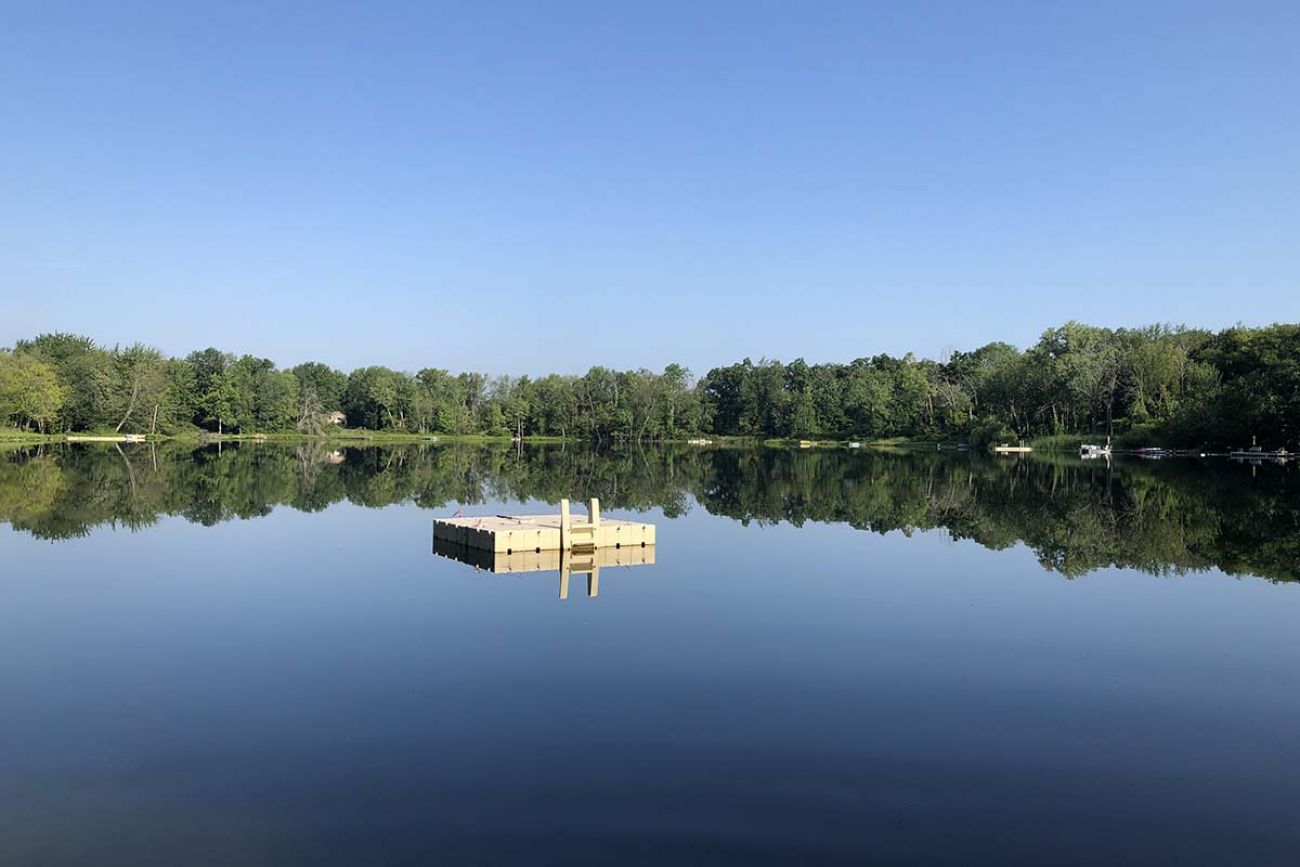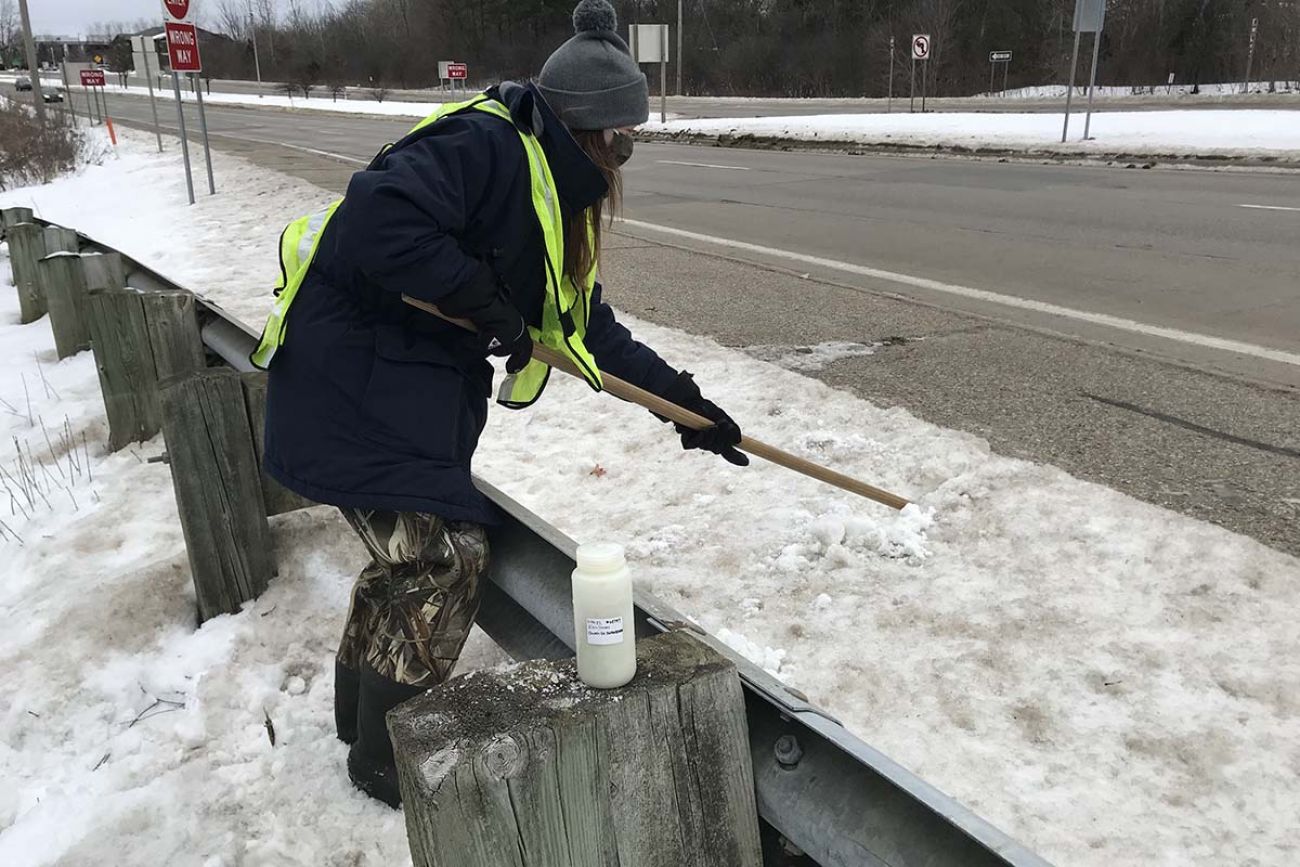
By Kelly House, Bridge Michigan
The Great Lakes News Collaborative includes Bridge Michigan; Circle of Blue; Great Lakes Now at Detroit Public Television; and Michigan Radio, Michigan’s NPR News Leader; who work together to bring audiences news and information about the impact of climate change, pollution, and aging infrastructure on the Great Lakes and drinking water. This independent journalism is supported by the Charles Stewart Mott Foundation. Find all the work HERE.
On the surface, Church Lake looks like a shining example of the glacier-carved lakes that are Michigan’s pride, its clear shallows teeming with heron, turtles, frogs and fish.
“It’s what’s lurking underneath that’s the issue,” said Ellen Foley, a graduate researcher studying the lake’s chemistry.
Meters beneath its vibrant surface, Church Lake is a dead zone — a chemical soup of phosphorus and road salt has left the water toxic and oxygen-deprived.
The Grand Rapids lake is a case study in how routine facets of modern Michigan life, such as salting roads, fertilizing lawns, and flushing toilets, have quietly tainted water from the Upper Peninsula to the state’s southern border.
Chloride, a component of road salt, is present in Church Lake at levels more than double the amount state officials say is dangerous to aquatic life.
Levels of phosphorus — a life-sustaining nutrient that becomes dangerous when it gets too concentrated — are even more shocking: Lakes are considered eutrophic, or high in nutrients, at about 20 to 30 parts-per-billion. Church Lake’s salt problem has trapped phosphorus in the lake, producing levels exceeding 6,000 parts-per-billion.
Foley and other researchers at Grand Valley State University’s Robert B. Annis Water Research Institute detected the shocking pollution after lakeside residents, concerned about runoff of road salt from a nearby highway and surrounding developments, commissioned a study of the lake’s chemistry.

Samples collected from Church Lake as part of a Grand Valley State University research project have revealed alarming levels of salt and nutrient pollution. (Photo courtesy of Ellen Foley)
Early results show “a biological ticking time bomb,” Foley said. “We don’t know what the breaking point is.”
Excess nutrients rob lakes of oxygen, causing fish to suffocate. When combined with sunlight and warmth, they can cause plants and algae to grow out of control, including the toxic cyanobacteria that can sicken humans and wildlife. Salt, meanwhile, harms freshwater organisms, stunting their development. High concentrations can kill them outright.
For now, those threats are trapped at the bottom of the lake, out of sight. The salt makes the deep water too heavy to mix with water near the surface.
But if even a portion of the bottom water is disturbed, reaching the surface where it could stimulate plant growth, toxic algae blooms could follow.
And the lake’s inability to mix has caused problems of its own. Seasonal water “turnover,” triggered by changing water temperatures, is a staple of healthy Michigan lakes that distributes oxygen and nutrients through the water column.
Robbed of this process, Church Lake’s deep water has “no oxygen whatsoever,” Foley said.
A lake disrupted
Church Lake, a 20-acre private kettle lake in an affluent area of Grand Rapids, sits within throwing distance of a major thoroughfare: Michigan Highway 44, also known as East Beltline Avenue, a trunkline highway that shuttles 24,000 vehicles daily along Grand Rapid’s east end. The area has seen more development in recent years, with new houses and businesses cropping up nearby.
When Laurie and Don Gardner moved to the lake in 1971, the Beltline was “a two-lane scenic drive,” Laurie said. The development in decades since, she said, has been “mind-boggling.”
Residents noticed how during a snowmelt or after a rainfall, murky water would flow out of the drain that collects water from the roadway and feeds it into Church Lake. After an initial study raised alarm about salt and phosphorus, the GVSU team began their work in 2020, leading to new revelations about the extent of pollution.
Lakeside residents say they’re frustrated by a problem that is not of their making. They maintain vegetation buffers along their property to reduce runoff and erosion into the lake. They don’t fertilize their lawns. Motor boats are banned. And unlike some Michigan lakes plagued by a proliferation of leaky septic systems, most Church Lake residents have switched to city water.
“We keep control from our entrance points,” said resident Bob Woodhouse, 67.
Researchers aren’t sure where the phosphorus originated. But they believe it has accumulated to alarming levels because the salt buildup stopped the seasonal mixing that would have otherwise allowed plants to gradually take up the nutrients.
The source of the salt problem, researchers say, is far clearer: It’s pouring off East Beltline Avenue. When snow melts off the road in large quantities, chloride levels in the drain that feeds Church Lake can spike as high as 1,000 parts-per-million.=
“That’s close to brackish water at that point,” Foley said.

Ellen Foley, a GVSU researcher leading a study into Church Lake’s pollution problems, collects snow from East Beltline Avenue to study the impacts of road salt on nearby Church Lake. (Courtesy photo)
A ‘ubiquitous’ problem
Church Lake is not unique, though it may be a particularly extreme case.
Alan Steinman, the Allen and Helen Hunting Director of the GVSU research institute behind the study, called the lake “a harbinger of what’s to come in the future” if road salt use continues unabated.
“This is a problem that is ubiquitous, it’s growing, and it needs to be addressed,” Steinman said. “And right now, because (the impact on water quality) is out of sight, it’s out of mind.”
Kevin Goodwin, an aquatic biologist with the Michigan Department of Environment, Great Lakes and Energy (EGLE), said Church Lake’s one-two punch of both salt and nutrient pollution appears to be uncommon. But many Michigan waterways suffer from one of the two.
As Bridge reported last month, new research reveals the region’s reliance on rock salt is even salinating Lake Michigan, a massive water body known for being “unsalted and shark-free.” Toxic algae blooms caused by nutrient overgrowth are a growing problem across the Great Lakes region, too.
But salt is an abundant and effective means of keeping drivers safe on winter roads. One study found it reduces collisions by up to 85 percent. Those benefits, along with a lack of viable alternatives, have made it difficult to rein in salt use, which has tripled nationwide since the 1970s.
In 2019, EGLE established water quality values for chloride, a step toward better monitoring and fixing salt pollution in Michigan’s lakes and rivers. The state does not limit how much salt can exit storm drains into waterways, but it is pushing government agencies to adopt “best management practices,” such as recalibrating salt trucks and conducting outreach to the public in hopes of reducing salt use.
The Kent County Road Commission, which maintains East Beltline Avenue through a contract with the Michigan Department of Transportation, has reduced salt use by about 15 percent in the past decade, according to numbers provided by the commission’s spokesperson.
And county road officials continue searching for ways to ration salt, said Jerry Byrne, the road commission’s deputy managing director of operations.
“But nobody wants to talk about it on a snow day,” Byrne said. And least of all on roads as heavily-traveled as East Beltline Avenue.
“Until the public changes their perceptions and their expectations,” of driving on bare asphalt just hours after a snowstorm, Byrne said, “road authorities can’t by themselves greatly reduce the amount of de-icing chemicals that go down.”
And salt applied by public road crews isn’t the only culprit in the lake’s salt problem, he noted. Increased development has created more parking lots, driveways and sidewalks that are often heavily-salted.
Assuming the salt will keep flowing off Beltline, Church Lake residents are focused on how to address its impact on the lake. Options include everything from diverting runoff into a retention pond, to pumping the polluted bottom water out of the lake.
Both would be expensive. And Foley noted that neither would address the root cause of a problem that isn’t confined to Church Lake.
“Unfortunately, it’s a human safety versus ecological health problem at this point,” she said. “The human safety part is going to win out until we find something that keeps us just as safe.”
Catch more news on Great Lakes Now:
Scientists race to gather winter data on warming Great Lakes
Road salt threatens Michigan lakes and rivers. Can an alternative take hold?
Featured image: Church Lake looks great, on the surface. (Photo courtesy of Laurie Gardner)




